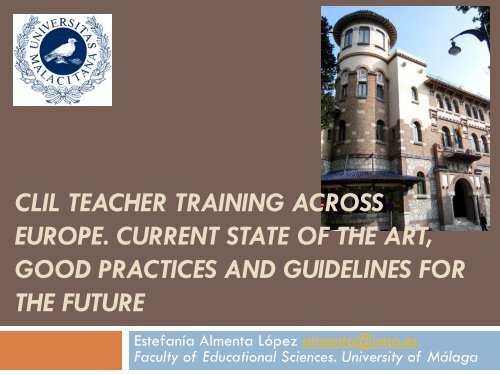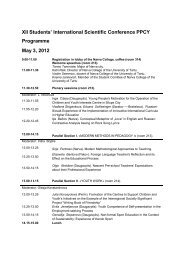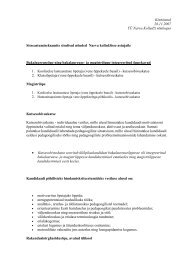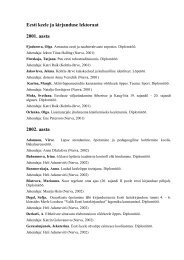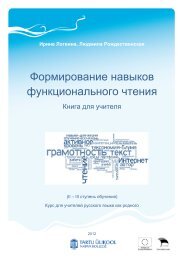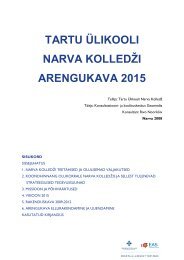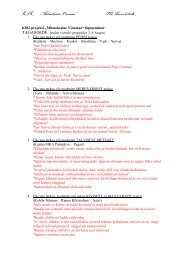CLIL Teacher's Competence Grid
CLIL Teacher's Competence Grid
CLIL Teacher's Competence Grid
Create successful ePaper yourself
Turn your PDF publications into a flip-book with our unique Google optimized e-Paper software.
<strong>CLIL</strong> TEACHER TRAINING ACROSS<br />
EUROPE. CURRENT STATE OF THE ART,<br />
GOOD PRACTICES AND GUIDELINES FOR<br />
THE FUTURE<br />
Estefanía Almenta López almenta@uma.es<br />
Faculty of Educational Sciences. University of Málaga
Presentation Overview<br />
A few words about <strong>CLIL</strong><br />
<strong>CLIL</strong> across Europe<br />
<strong>CLIL</strong> teachers’ profile<br />
Pre-service training for <strong>CLIL</strong> teachers<br />
In-service training for <strong>CLIL</strong> teachers<br />
Which competences for <strong>CLIL</strong> teachers?<br />
How can we develop those competences?<br />
Guidelines for future action<br />
Discussion and final remarks
A few words about <strong>CLIL</strong><br />
<strong>CLIL</strong> is an umbrella term covering a dozen or more<br />
educational approaches (eg, immersion, bilingual<br />
education, multilingual education, language showers<br />
and enriched language programmes).<br />
<strong>CLIL</strong> synthesizes and provides a flexible way of<br />
applying the knowledge learnt from these various<br />
approaches.<br />
<strong>CLIL</strong> allows for low-to-high-intensity exposure to<br />
teaching/learning through the second language.
<strong>CLIL</strong> across Europe (1/6)<br />
Language teaching has been present in the<br />
European recommendations on education for many<br />
years.<br />
The goal has always been to promote linguistic<br />
diversity, understood as a key factor in ensuring the<br />
success of the European project.<br />
In this context, the EU has developed several<br />
initiatives in the field of <strong>CLIL</strong>.<br />
Nevertheless, the methodological approach <strong>CLIL</strong> is<br />
still new and its degree of implementation varies<br />
widely among European Union countries.
<strong>CLIL</strong> across Europe (2/6)<br />
The vast majority of European countries offer <strong>CLIL</strong><br />
programs in mainstream education, both primary<br />
and secondary, although often not all students<br />
attending <strong>CLIL</strong> schools receive <strong>CLIL</strong> teaching.<br />
The most common situation is that schools provide<br />
parallel paths of regular education and <strong>CLIL</strong><br />
education.<br />
About a third of these countries also have pilot<br />
programs to implement this type of education.
<strong>CLIL</strong> across Europe (3/6)<br />
Thus, the fact that the <strong>CLIL</strong> approach is part of<br />
mainstream education does not mean that it is<br />
widespread.<br />
It is still unusual the case of countries such as<br />
Luxembourg and Malta, where the teaching of <strong>CLIL</strong><br />
exists in all schools across the board.<br />
In other countries, this type of education seems to be<br />
aimed at a minority of students ranging between<br />
3% and 30% in the levels of primary and / or<br />
secondary.
<strong>CLIL</strong> across Europe (4/6)<br />
<strong>CLIL</strong> mode in which regional or minority languages<br />
are used is more widespread, of course, in areas with<br />
several official languages such as Spain, Italy, the<br />
Netherlands and the United Kingdom (Wales and<br />
Scotland).<br />
From the chronological point of view, these areas<br />
have generally been first to introduce the teaching of<br />
<strong>CLIL</strong> type.<br />
<strong>CLIL</strong> teaching in one or more foreign languages has<br />
been introduced later and at different times, starting<br />
in the 80’s.
<strong>CLIL</strong> across Europe (5/6)<br />
<strong>CLIL</strong> education is offered mainly in the educational<br />
levels of primary, lower secondary and upper<br />
secondary. Some countries also have <strong>CLIL</strong> from the<br />
kindergarten stage.<br />
The duration of the <strong>CLIL</strong> is highly variable across<br />
Europe. In some cases may comprise the entire<br />
period of compulsory education (usually between 6<br />
and 16 years), but it is difficult to establish a<br />
general rule, given the organizational autonomy<br />
enjoyed by schools.
<strong>CLIL</strong> across Europe (6/6)<br />
In most European countries, the choice of subjects<br />
taught in <strong>CLIL</strong> varies among schools and regions.<br />
The most common situation is that schools are able<br />
to choose one or more subjects in the curriculum<br />
based on the center's needs and on available<br />
resources (eg, qualification of teachers).<br />
In primary education, the subjects usually taught in<br />
<strong>CLIL</strong> are creative, sports or environmental.<br />
Regarding secondary education, <strong>CLIL</strong> is mainly<br />
applied to Science areas or Social sciences.
<strong>CLIL</strong> teachers’ profile (1/6)<br />
As we have seen, <strong>CLIL</strong> programs are offered in most<br />
European countries, in almost all educational levels<br />
and in a variety of subjects.<br />
In this context, we find a group of teachers with new<br />
training needs both in the content and the target<br />
language of <strong>CLIL</strong> programs.<br />
<strong>CLIL</strong> teachers should be proficient in the content area<br />
and at the same time have a broad knowledge of<br />
foreign language learning, thereby providing<br />
optimal conditions for student communication (Marsh,<br />
2002).
<strong>CLIL</strong> teachers’ profile (2/6)<br />
There is no doubt that a <strong>CLIL</strong> teacher needs a<br />
specific training that goes beyond the formation of<br />
a foreign language teacher or a subject teacher<br />
(Wolff, 2002).<br />
This makes specific the profile of these teachers,<br />
who have therefore a double specialisation.<br />
<br />
However, the situation of teachers responsible for<br />
delivering these programs varies greatly from<br />
country to country. This dual expertise required is<br />
sought in many ways.
<strong>CLIL</strong> teachers’ profile (3/6)<br />
<strong>CLIL</strong> teachers generally meet the necessary<br />
requirements to perform such work in the<br />
corresponding level of regular education (usually a<br />
university degree in one of the regular curriculum<br />
subjects).<br />
There is also the case of teachers specializing in one<br />
or more non-linguistic areas, as well as of those with<br />
a double major (one language and other nonlinguistic).
<strong>CLIL</strong> teachers’ profile (4/6)<br />
Besides teaching qualification, some countries<br />
require certificates to prove the level of knowledge<br />
of the target language in the <strong>CLIL</strong> program.<br />
However, none of the certificates required relates to<br />
<strong>CLIL</strong> teaching qualifications (teaching principles and<br />
methodology).<br />
Several factors may explain why no additional<br />
credentials are required to work as a teacher <strong>CLIL</strong>.
<strong>CLIL</strong> teachers’ profile (5/6)<br />
Sometimes the <strong>CLIL</strong> is not well developed in the<br />
country or only existed for some time as a pilot<br />
project.<br />
If <strong>CLIL</strong> is widespread or is the normal practice, <strong>CLIL</strong><br />
training is considered ordinary and does not specify<br />
any additional requirements.<br />
In the case of <strong>CLIL</strong> with regional or minority<br />
languages, it is taken for granted that teachers<br />
generally have a good command of two languages<br />
(the mother and the co-official).
<strong>CLIL</strong> teachers’ profile (6/6)<br />
Notwithstanding the above, some countries are<br />
already developing certification to establish specific<br />
training in <strong>CLIL</strong>.<br />
Although these certifications are not a mandatory<br />
requirement, they are beginning to be considered as<br />
an added value when applying for a job as a <strong>CLIL</strong><br />
teacher.<br />
This fosters the implementation of <strong>CLIL</strong> programs with<br />
greater assurance, given the consideration that one<br />
of the main obstacles to the success of this type of<br />
education is the shortage of qualified teachers.
Pre-service training for <strong>CLIL</strong><br />
teachers (1/6)<br />
In almost all EU countries with <strong>CLIL</strong> teaching,<br />
educational authorities offer a course, module, subject<br />
or even specific degree for training in this<br />
methodology.<br />
However, training options are very limited in practice,<br />
and is not accessible to the majority of future<br />
teachers.<br />
In any case, these training opportunities are not<br />
usually a requirement for the practice of <strong>CLIL</strong><br />
teaching in most countries. Furthermore, characteristics<br />
and duration are highly variable.
Pre-service training for <strong>CLIL</strong><br />
teachers (2/6)<br />
In Austria, training can consist of some classes or a<br />
course (one or two semesters). However, this training<br />
is not a requirement for selection for <strong>CLIL</strong> teachers.<br />
In the Netherlands and the United Kingdom<br />
(England), some universities offer graduate degrees<br />
or other qualifications focused on bilingual and<br />
international education. However, as it is the case in<br />
Austria, they are not a requirement to work as a<br />
<strong>CLIL</strong> teacher.
Pre-service training for <strong>CLIL</strong><br />
teachers (3/6)<br />
In the United Kingdom (Wales), the so-called ‘Welsh<br />
Medium Incentive Supplement’ aims to encourage<br />
student teachers to finish their initial teacher<br />
training in Welsh to improve their language<br />
proficiency for teaching purposes.<br />
In the United Kingdom (Northern Ireland) there is a<br />
certificate of bilingual education and immersion for<br />
the primary level, though it is not a requirement for<br />
the practice of teaching.
Pre-service training for <strong>CLIL</strong><br />
teachers (4/6)<br />
In Germany, some Länder have developed special<br />
further qualifications for bilingual education<br />
(Bilinguales Lernen; Euregio-Lehrer) both in the target<br />
language and in another subject of the curriculum.<br />
Students are able to obtain these qualifications<br />
while doing their studies, after their first degree or<br />
during their practical training (internship).<br />
In France there is an additional certificate for<br />
teaching non-language areas in a foreign language<br />
since December 2003 (although not a requirement<br />
to practice as a <strong>CLIL</strong> teacher).
Pre-service training for <strong>CLIL</strong><br />
teachers (5/6)<br />
In Finland, there are two types of initial training for<br />
<strong>CLIL</strong>: one for teaching the language in which <strong>CLIL</strong> is<br />
the other official language, and one for teaching<br />
the language in which <strong>CLIL</strong> is a foreign language.<br />
The first mode is the most widespread and better<br />
organized, because it has a longer tradition in the<br />
country.<br />
In Spain there are optional modules in some<br />
degrees and post-graduate courses. Recently some<br />
Master degrees completely dedicated to <strong>CLIL</strong><br />
training have been created.
Pre-service training for <strong>CLIL</strong><br />
teachers (6/6)<br />
In Poland, the new legislation introduced in 2004<br />
established the obligation for new teachers to<br />
specialize in a second subject. If they choose to<br />
specialize in a linguistic area and a foreign<br />
language, C2 level (CEFR) is required.<br />
In some countries such as Lithuania, Poland and<br />
Bulgaria, training in collaboration with the embassies<br />
or cultural services of foreign countries have been<br />
established, such as the British Council (jointly<br />
organized courses, teaching practice periods and<br />
visits to the country of the <strong>CLIL</strong> target language).
In-service training for<br />
<strong>CLIL</strong> teachers (1/8)<br />
In-service training education for <strong>CLIL</strong> teachers varies<br />
widely between different regions. In general, the<br />
characteristics of the training options depend on the<br />
type of <strong>CLIL</strong> to which they are directed.<br />
For <strong>CLIL</strong> teaching in pilot experiments, usually<br />
specific courses or temporary groups are organised<br />
to support implementation of these experiences. This<br />
is the case in Belgium (Flemish Community).
In-service training for<br />
<strong>CLIL</strong> teachers (2/8)<br />
In some countries like the Czech Republic, in-service<br />
training is based on international cooperation<br />
agreements with agencies for the dissemination of<br />
foreign language (such as Alliance Française and the<br />
Goethe Institut).<br />
In Latvia, the National Agency for Latvian<br />
Language Training (NALLT), offers courses in<br />
bilingual teaching methodology (Latvian and<br />
Russian) for teachers.
In-service training for<br />
<strong>CLIL</strong> teachers (3/8)<br />
In Estonia there is a program that aims the<br />
introduction in Russian schools of Estonian as the<br />
language of instruction. This program includes<br />
teacher training and materials development.<br />
In the case of Sweden, teachers who have extensive<br />
experience act as trainers for new teachers, in<br />
cooperation with teacher training institutions<br />
abroad.
In-service training for<br />
<strong>CLIL</strong> teachers (4/8)<br />
In the case of Spain, usually the ‘Teachers Training<br />
Centres’ are in charge of <strong>CLIL</strong> teachers training. This<br />
training includes specific courses on methodology, in<br />
integrating content and language, on preparation<br />
of teaching materials and on teacher cooperation.<br />
There are also refresher language courses for nonlinguistic<br />
areas teachers. Teachers can also apply<br />
for courses abroad to improve their language and<br />
methodological skills.
In-service training for<br />
<strong>CLIL</strong> teachers (5/8)<br />
While training is generally not mandatory, some<br />
countries (Italy, the Netherlands, Austria and Finland<br />
in the case of <strong>CLIL</strong> with foreign language) strongly<br />
recommend that teachers receive in-service training<br />
for <strong>CLIL</strong>.<br />
In some countries teachers receive incentives or<br />
compensation for taking the time to continue their<br />
education.<br />
In the case of Italy, this training is mandatory<br />
because it is directly related to the development of<br />
pilot projects.
In-service training for<br />
<strong>CLIL</strong> teachers (6/8)<br />
Moreover, in addition to the training received by<br />
teachers, many European countries have in their<br />
schools the presence of assistants (native speakers<br />
of the <strong>CLIL</strong> target language). In this way teachers<br />
and students benefit from exposure to a native<br />
language model.<br />
The presence of these native speakers is viable in<br />
many cases through transnational agreements. In<br />
other cases the schools themselves with their<br />
resources, or with the help of funding from parent<br />
associations, hire assistants (eg Austria).
In-service training for<br />
<strong>CLIL</strong> teachers (7/8)<br />
Another way for <strong>CLIL</strong> teacher training is the creation<br />
of websites and online teachers communities.<br />
Although these initiatives began its way timidly, now<br />
there are numerous physical and virtual platforms for<br />
<strong>CLIL</strong> teachers, and its development potential is much<br />
higher today.<br />
As for training projects funded at European level, we<br />
can mention MOBIDIC (2000-2004), involving<br />
Germany, France, Poland and the UK (England). Its<br />
goal was to create modules for initial and in-service<br />
training of teachers of non-linguistic areas imparting<br />
their subjects in a foreign language.
In-service training for<br />
<strong>CLIL</strong> teachers (8/8)<br />
There is also the CCN Project (<strong>CLIL</strong> Cascade<br />
Network, 2008), which is configured as a<br />
multilateral network financed by the European<br />
Commission. It aims to promote skills development<br />
and teachers training, and to build local <strong>CLIL</strong><br />
competencies.<br />
Recently this network has published the so-called<br />
"<strong>CLIL</strong> <strong>Teacher's</strong> <strong>Competence</strong> <strong>Grid</strong>" (Bertaux et al.,<br />
2010), which sets out the basic skills and<br />
competencies to be developed by <strong>CLIL</strong> teachers.
Which competences for <strong>CLIL</strong><br />
teachers? (1/12)<br />
<strong>CLIL</strong> teacher's competences grid (Pat Bertaux, Carmel Mary<br />
Coonan, María Jesús Frigols-Martín, Peeter Mehisto, 2010).<br />
The Teacher <strong>Competence</strong>s <strong>Grid</strong> is a tool for<br />
reflecting on and guiding professional development<br />
for future and currently in-service <strong>CLIL</strong> teachers. It is<br />
not a list of pre-service requirements for <strong>CLIL</strong><br />
teachers but represents a skills set to be aimed at in<br />
<strong>CLIL</strong>.<br />
This grid presents teacher competences that can<br />
support the construction of rich <strong>CLIL</strong> learning<br />
environments.
Which competences for <strong>CLIL</strong><br />
teachers? (2/12)<br />
These competences need to be further situated in<br />
the context of best practice in education in general.<br />
Moreover, the local context will place its own<br />
demands on <strong>CLIL</strong> teachers.<br />
The grid offers a point of reference for discussions<br />
pertaining to <strong>CLIL</strong> teaching and teacher<br />
development.
Which competences for <strong>CLIL</strong><br />
teachers? (3/12)<br />
A successful <strong>CLIL</strong> teacher is not expected to have all<br />
of these competences.<br />
S/he may be able to compensate for a lack of<br />
knowledge in one area with high levels of expertise<br />
in another.<br />
While the grid can be used by a <strong>CLIL</strong> teacher for<br />
identifying professional development needs, its<br />
comprehensive nature means it is not a suitable tool<br />
for evaluating teaching practice.
Which competences for <strong>CLIL</strong><br />
teachers? (4/12)<br />
The grid is divided into two sections: a)<br />
underpinning <strong>CLIL</strong>; b) setting <strong>CLIL</strong> in motion.<br />
The first section is primarily focused on the<br />
competences and stakeholder relationships that are<br />
essential to laying the foundation for establishing<br />
and maintaining a <strong>CLIL</strong> programme.<br />
The second focuses on the competences and<br />
stakeholder relationships which are important to<br />
<strong>CLIL</strong> implementation.
Which competences for <strong>CLIL</strong><br />
teachers? (5/12)<br />
Core <strong>CLIL</strong> activators (Mehisto, P., Bertaux, P.,<br />
Frigols-Martín, M.J., 2009)<br />
These 'Core <strong>CLIL</strong> Activators' represent a synthesis of<br />
key elements of good pedagogy and good <strong>CLIL</strong><br />
practice. They also depict some of the ways <strong>CLIL</strong><br />
stakeholders work together to build a learning<br />
community, and, in particular, rich learning<br />
environments for students.
Which competences for <strong>CLIL</strong><br />
teachers? (6/12)
Which competences for <strong>CLIL</strong><br />
teachers? (7/12)<br />
<strong>CLIL</strong> across contexts: A scaffolding framework for<br />
<strong>CLIL</strong> teacher education<br />
<strong>CLIL</strong> across contexts site (Marie-Anne Hansen-Pauly, Vic Jovanovic,<br />
Danielle Zerbato, Guy Bentner, Ana Llinares, Thomas Morton, Emma Dafouz-<br />
Milne, Concepción Erades Alonso, Montserrat García Comino, Aina Carreras<br />
Nadal, Franco Favilli, Liz Dale, Penelope Robinson, Marie Hofmannova,<br />
Jarmila Novotna).<br />
It is a 3-year (2006-2009) SOCRATES-COMENIUS<br />
2.1 project which aims at proposing a model for<br />
teacher education based on classroom observation<br />
and relevant research in selected areas of bilingual<br />
education and learning in general.
Which competences for <strong>CLIL</strong><br />
teachers? (8/12)<br />
It has also generated local actions in the different<br />
countries where academics, teacher educators and<br />
<strong>CLIL</strong> teachers have worked together towards<br />
identifying crucial aspects of effective teaching and<br />
learning.<br />
The key ideas of the project show the stress on<br />
common concerns, like the importance of teacher<br />
cooperation, classroom interaction and scaffolding<br />
for <strong>CLIL</strong> situations.
Which competences for <strong>CLIL</strong><br />
teachers? (9/12)<br />
Specific local needs are taken into account. The<br />
linguistic diversity of contexts adds a multilingual<br />
perspective, which is linked to a variety of learning<br />
cultures and social expectations.<br />
The bottom-up approach to the development of a<br />
framework reflects the intrinsic coherence of the<br />
project and the partners’ collaborative approach.<br />
This movement from observation to theoretical<br />
considerations and their impact on approaches to<br />
teacher education as well as projected outcomes in<br />
classroom practice is reflected in the different stages<br />
of the project.
Which competences for <strong>CLIL</strong><br />
teachers? (10/12)
Which competences for <strong>CLIL</strong><br />
teachers? (11/12)<br />
<strong>CLIL</strong> Essentials (Mehisto & Lucietto, 2010).<br />
<strong>CLIL</strong> Essentials represent some key elements essential<br />
to <strong>CLIL</strong> practice.<br />
Managing the affective side, making learning visible, high<br />
expectations + high levels of engagement for all,<br />
interdependence of language and cognition, making<br />
academic language visible, reflecting on learning,<br />
fostering critical thinking, taking time for making learning<br />
meaningful, scaffolding language, reflecting on teaching,<br />
scaffolding content, asymmetry in classroom talk in favour<br />
of students, connecting with <strong>CLIL</strong> language speakers,<br />
cooperative learning, fostering learner autonomy.
How can we develop those<br />
competencies? (Universität Wien)
How can we develop those<br />
competencies? (IVLOS, Universiteit Utrecht)<br />
U-TEAch (1-year<br />
master)<br />
CONCEPTUAL &<br />
MATERIAL TOOLS<br />
ACTORS<br />
PLACES<br />
ACTIVITIES
Guidelines for future action<br />
(1/2)<br />
Language proficiency (native assistants)<br />
Multicultural awareness<br />
Reflective teacher (debriefing, logbook)<br />
Collaborative and cooperative teaching (team<br />
teaching)<br />
Peer feedback<br />
Experienced and starting teachers working together<br />
Internship (School and University mentors, from<br />
observing to teaching)
Guidelines for future action<br />
(2/2)<br />
Theory and practice on parallel<br />
Research skills<br />
Class materials<br />
Literature<br />
Experience <strong>CLIL</strong> methodology and principles<br />
Physical & virtual network (resources bank,<br />
communication room, sharing ideas and problems)<br />
Portfolio (responsability for own learning)<br />
Professional attitude<br />
Joint enterprise
Discussion and final remarks (1/4)<br />
The process of globalization demands that<br />
educational systems adapt to the new configuration<br />
of society.<br />
A focus of special attention is teaching and learning<br />
languages.<br />
In this sense, <strong>CLIL</strong> appears in an attempt to meet the<br />
training needs of new generations.<br />
The ability of <strong>CLIL</strong> to promote and develop<br />
multilingual and multicultural competence of citizens<br />
has already been demonstrated, but there is still<br />
much potential to be developed.
Discussion and final remarks(2/4)<br />
Many authors agree that the success of these<br />
programs depends on the skills of professionals<br />
responsible for their implementation.<br />
It is not enough to master the content and language,<br />
but we must go further to be able to effectively<br />
integrate the two and have the ability to create a<br />
conducive learning environment while acquiring<br />
learning strategies. In other words, it requires a<br />
mastery of specific teaching strategies <strong>CLIL</strong>.
Discussion and final remarks (3/4)<br />
Thus, it is necessary to develop training programs<br />
specifically aimed at <strong>CLIL</strong> teachers, both for preand<br />
in-service training of these professionals.<br />
Furthermore, these programs should be supported<br />
by activities such as specialist teacher mobility<br />
between European countries and the creation of<br />
networks on <strong>CLIL</strong>.
Discussion and final remarks (4/4))<br />
Many graduates will be required to practice <strong>CLIL</strong> at<br />
schools<br />
Create & offer a basic pre-service qualification and<br />
an in-service follow-up module<br />
In many cases, it needs to fit the mould of an existing<br />
degree curriculum<br />
Economical resources for <strong>CLIL</strong> teacher training<br />
(organizational structure required for <strong>CLIL</strong> programs<br />
is larger than traditional teaching. The teaching<br />
materials and human resources require significant<br />
changes to accommodate this type of education.)
Thank you!<br />
Aitäh!<br />
спасибо<br />
Estefanía Almenta López (almenta@uma.es)<br />
School Organisation and Didactics Department<br />
Faculty of Educational Sciences<br />
University of Málaga (www.uma.es)


